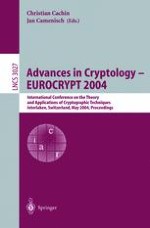These are the proceedings of Eurocrypt 2004, the 23rd Annual Eurocrypt C- ference. The conference was organized by members of the IBM Zurich Research Laboratory in cooperation with IACR, the International Association for Cr- tologic Research. Theconferencereceivedarecordnumberof206submissions,outofwhichthe program committee selected 36 for presentation at the conference (three papers were withdrawn by the authors shortly after submission). These proceedings contain revised versions of the accepted papers. These revisions have not been checked for correctness, and the authors bear full responsibility for the contents of their papers. The conference program also featured two invited talks. The ?rst one was the 2004 IACR Distinguished Lecture given by Whit?eld Di?e. The second invited talk was by Ivan Damg? ard who presented “Paradigms for Multiparty Computation. ” The traditional rump session with short informal talks on recent results was chaired by Arjen Lenstra. The reviewing process was a challenging task, and many good submissions had to be rejected. Each paper was reviewed independently by at least three members of the program committee, and papers co-authored by a member of the program committee were reviewed by at least six (other) members. The individual reviewing phase was followed by profound and sometimes lively d- cussions about the papers, which contributed a lot to the quality of the ?nal selection. Extensive comments were sent to the authors in most cases.
